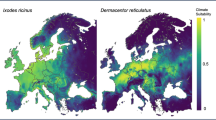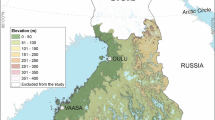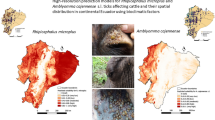Abstract
Rhipicephalus annulatus is a tick species of veterinary importance due to its potential to transmit babesiosis to cattle. This species has a Holarctic distribution with some Afrotropical records and is one-host species of veterinary importance. This study was carried out from September 2021 to February 2022 at 6 Egyptian collection sites, and a total of 1150 cattle were scanned randomly to collect ticks. A total of 1095 tick specimens were collected and identified as R. annulatus using taxonomic keys. Males were found on all parts of the cattle except the head and around the eyes, but females were found on all parts; in addition, the highest number of specimens was gathered from the udder, (neck and chest), and belly. Maximum entropy (MaxEnt) modeling was used to predict the potential global distribution of R. annulatus. The MaxEnt model performed better than random with an average test area under the curve (AUC) value of 0.96, and model predictions were significantly better than random and gave (AUC) ratios above the null expectations in the partial receiver operating characteristic (pROC) analyses (P < 0.001). Based on correlation analyses, a set of 9 variables was selected for species from 15 bioclimatic and 5 normalized difference vegetation index (NDVI) variables. The study showed that the current distribution of R. annulatus is estimated to occur across Asia, Africa, Europe, South America, and North America. Annual mean temperature (Bio1) and median NDVI had the highest effect on the distribution of this species. The environmentally suitable habitat for R. annulatus sharply increased with increasing annual mean temperature (Bio1). These results can be used for making effective control planning decisions in areas suitable to this vector of many diseases worldwide.









Similar content being viewed by others
Data availability
Not applicable.
References
Aboelhadid SM, Arafa WM, Wahba A, Mahrous LN, Ibrahium SM, Holman PJ (2018) Effect of high concentrations of lufenuron, pyriproxyfen and hydroprene on Rhipicephalus (Boophilus) annulatus. Vet Parasitol 256:35–42
Barve N, Barve V, Jiménez-Valverde A, Lira-Noriega A, Maher SP, Peterson AT, Soberón J, Villalobos F (2011) The crucial role of the accessible area in ecological niche modeling and species distribution modeling. Ecol Modell 222:1810–1819
Bock R, Jackson L, De Vos A, Jorgensen W (2004) Babesiosis of cattle. Parasitology 129:S247–S269
Boorgula GD, Peterson AT, Foley DH, Ganta RR, Raghavan RK (2020) Assessing the current and future potential geographic distribution of the American dog tick, Dermacentor variabilis (Say) (Acari: Ixodidae) in North America. PLoS ONE 15(8):e0237191
Dantas-Torres F, Onofrio VC, Barros-Battesti DM (2009) The ticks (Acari: Ixodida: Argasidae, ixodidae) of Brazil. Syst Appl Acarol 14:30–47
Dormann CF, Elith J, Bacher S, Buchmann C, Carl G, Carré G, Marquéz JRG, Gruber B, Lafourcade B, Leitão PJ, Münkemüller T (2013) Collinearity: a review of methods to deal with it and a simulation study evaluating their performance. Ecography 36(1):27–46
El Kammah K, Oyoun L, El Kady G, Shafy S (2001) Investigation of blood parasites in livestock infested with argasid and ixodid ticks in Egypt. J Egypt Soc Parasitol 31(2):365
Estrada-Peña A, Venzal J (2006) High-resolution predictive mapping for Boophilus annulatus and B. Microplus (Acari: Ixodidae) in Mexico and southern Texas. Vet Parasitol 142:350–358
Estrada-Peña A, Venzal JM (2007) Climate niches of tick species in the Mediterranean region: modeling of occurrence data, distributional constraints, and impact of climate change. J Med Entomol 44:1130–1138
Estrada-Peña A, Bouattour A, Camicas JL, Guglielmone A, Horak I, Jongejan F, Latif A, Pegram R, Walker AR (2006) The known distribution and ecological preferences of the tick subgenus Boophilus (Acari: Ixodidae) in Africa and Latin America. Exp Appl Acarol 38:219–235
Gabaj M, Awan M, Beesley W (1992) A survey of ticks on farm animals in Libya. Ann Trop Med Parasitol 86(5):543–548
Giles JR, Peterson AT, Busch JD, Olafson PU, Scoles GA, Davey RB, Pound JM, Kammlah DM, Lohmeyer KH, Wagner DM (2014) Invasive potential of cattle fever ticks in the southern United States. Parasit Vectors 7:189
Gindin G, Samish M, Alekseev E, Glazer I (2001) The susceptibility of Boophilus annulatus (Ixodidae) ticks to entomopathogenic fungi. Biocontrol Sci Technol 11(1):111–118
Graham MH (2003) Confronting multicollinearity in ecological multiple regression. Ecology 84(11):2809–2815
Graham OH, Price MA (1966) Some morphological variations in Boophilus annulatus microplus (Acarina: Ixodidae) from northern Mexico. Ann Entomol Soc 59:450–452
Guglielmone AA, Robbins RG (2018) Hard ticks (Acari: Ixodida: Ixodoidea) parasitizing humans. Springer, A global overview, 313 pp
Guglielmone AA, Robbins RG, Apanaskevich DA, Petney TN, Estrada-Peña A, Horak IG (2014) The hard ticks of the world: (Acari: Ixodida: Ixodidae). Springer Dordrecht, Heidelberg, 738 pp
Hassan MI, Gabr HS, Abdel-Shafy S, Hammad KM, Mokhtar MM (2017) Molecular detection of Borrelia sp. in ornithodoros savignyi and rhipicephalus annulatus by FlaB gene and babesia bigemina in R. annulatus by 18S rRNA gene. J Egypt Soc Parasitol 47:403–414
Hoogstraal H, Kaiser MN (1960) Observations on ticks (Ixodoidea) of Libya. Ann Entomol Soc 53(4):445–457
Hoogstraal H (1956) African Ixodoidea. I. Ticks of the Sudan (with special reference to Equatoria Province and with preliminary reviews of the genera Boophilus, Margaropus, and Hyalomma). Department of the Navy, Bureau of Medicine and Surgery, US Naval Medical Research Unit 3, Cairo, Egypt. 1100 pp.
Jongejan F, Uilenberg G (2004) The global importance of ticks. Parasitology 129:S3–S14
Kerario II, Muleya W, Chenyambuga S, Koski M, Hwang SG, Simuunza M (2017) Abundance and distribution of ixodid tick species infesting cattle reared under traditional farming systems in Tanzania. Afr J Agric Res 12:286–299
Kessler WH, Ganser C, Glass GE (2019) Modeling the distribution of medically important tick species in Florida. Insects 10(7):190
Khanum R, Mumtaz AS, Kumar S (2013) Predicting impacts of climate change on medicinal asclepiads of Pakistan using Maxent modeling. Acta Oecol 49:23–31
Klafke GM, Moreno HC, Tidwell JP, Miller RJ, Thomas DB, Feria-Arroyo TP, de León AAP (2020) Partial characterization of the voltage-gated sodium channel gene and molecular detection of permethrin resistance in Rhipicephalus annulatus (Say, 1821). Ticks Tick Borne Dis 11(3):101368
Kriticos DJ, Jarošik V, Ota N (2014) Extending the suite of bioclim variables: a proposed registry system and case study using principal components analysis. Methods Ecol Evol 5:956–960
Lobo JM, Jiménez-Valverde A, Real R (2008) Auc: a misleading measure of the performance of predictive distribution models. Glob Ecol Biogeogr 17:145–151
Loftis AD, Reeves WK, Szumlas DE, Abbassy MM, Helmy IM, Moriarity JR, Dasch GA (2006) Rickettsial agents in Egyptian ticks collected from domestic animals. Exp Appl Acarol 40:67–81
Lohmeyer KH, Pound JM, May MA, Kammlah DM, Davey RB (2011) Distribution of Rhipicephalus (Boophilus) microplus and Rhipicephalus (Boophilus) annulatus (Acari: Ixodidae) infestations detected in the United States along the Texas/Mexico border. J Med Entomol 48:770–774
Lorusso V, Picozzi K, de Bronsvoort BM, Majekodunmi A, Dongkum C, Balak G, Igweh A, Welburn SC (2013) Ixodid ticks of traditionally managed cattle in central Nigeria: where Rhipicephalus (Boophilus) microplus does not dare (yet?). Parasit Vectors 6(1):171
Mastropaolo M, Beltrán-Saavedra LF, Guglielmone AA (2014) The ticks (Acari: Ixodida: Argasidae, Ixodidae) of Bolivia. Ticks Tick Borne Dis 5:186–194
Mazyad S, Khalaf S (2002) Studies on theileria and babesia infecting live and slaughtered animals in Al Arish and El Hasanah, North Sinai Governorate. Egypt J Egypt Soc Parasitol 32(2):601–610
McCosker P (1981) The global importance of babesiosis. In: Ristic M, Kreier J (eds) Babesiosis. Academic Press Inc., 1–24 pp
Mesgaran MB, Cousens RD, Webber BL (2014) Here be dragons: a tool for quantifying novelty due to covariate range and correlation change when projecting species distribution models. Divers Distrib 20(10):1147–1159
Miller R, Estrada-Peña A, Almazán C, Allen A, Jory L, Yeater K, Messenger M, Ellis D, de León AAP (2012) Exploring the use of an anti-tick vaccine as a tool for the integrated eradication of the cattle fever tick, Rhipicephalus (Boophilus) annulatus. Vaccine 30:5682–5687
Murrell A, Barker SC (2003) Synonymy of Boophilus Curtice, 1891 with Rhipicephalus Koch, 1844 (Acari: Ixodidae). Syst Parasitol 56(3):169–172
Nasser M, El-Hawagry M, Okely M (2019) Environmental niche modeling for some species of the genus Anthrax Scopoli (Diptera: Bombyliidae) in Egypt with special notes on St Catherine protected area as a suitable habitat. J. Insect Conserv. 23(5):831–841
Nasser M, Okely M, Nasif O, Alharbi S, GadAllah S, Al-Obaid S, Enan R, Bala M, Al-Ashaal S (2021) Spatio-temporal analysis of Egyptian flower mantis Blepharopsis mendica (order: Mantodea), with notes of its future status under climate change. Saudi J Biol Sci 28(4):2049–2055
Okely M, Anan R, Gad-Allah S, Samy AM (2020) Mapping the environmental suitability of etiological agent and tick vectors of Crimean-Congo hemorrhagic fever. Acta Trop 203:105319
Okely M, Nasser M, Enan R, GadAllah S, AlAshaal S (2020b) Mantodea oasis of Palaearctic region: biogeographical analysis of Mantodea in Egypt. Egypt J Biol Pest Control 30(1):1–10
Okely M, Anan R, Gad-Allah S, Samy AM (2021) Hard ticks (Acari: Ixodidae) infesting domestic animals in Egypt: diagnostic characters and a taxonomic key to the collected species. Med Vet Entomol 35(3):333–351
Okely M, Chen Z, Anan R, Gad-Allah S (2022) Updated checklist of the hard ticks (Acari: Ixodidae) of Egypt, with notes of livestock host and tick-borne pathogens. Syst Appl Acarol 27(5):811–838
Pascoe EL, Marcantonio M, Caminade C, Foley JE (2019) Modeling potential habitat for Amblyomma tick species in California. Insects 10(7):201
Peterson AT, Pereira RS, Neves VFDC (2004) Using epidemiological survey data to infer geographic distributions of leishmaniasis vector species. Rev Soc Bras Med Trop 37:10–14
Peterson AT, Papeş M, Soberón J (2008) Rethinking receiver operating characteristic analysis applications in ecological niche modeling. Ecol Modell 213(1):63–72
Peterson AT, Soberón J, Pearson RG, Anderson RP, Martínez-Meyer E, Nakamura M, Araújo MB (2011) Ecological niches and geographic distributions (mpb-49), vol 56. Princeton University Press, NJ,USA, pp 97–137
Phillips SJ, Anderson RP, Schapire RE (2006) Maximum entropy modeling of species geographic distributions. Ecol Modell 190:231–259
Popara M, Villar M, Mateos-Hernández L, de Mera IGF, Marina A, del Valle M, Almazán C, Domingos A, de la Fuente J (2013) Lesser protein degradation machinery correlates with higher BM86 tick vaccine efficacy in Rhipicephalus annulatus when compared to Rhipicephalus microplus. Vaccine 31(42):4728–4735
Raghavan RK, Goodin DG, Hanzlicek GA, Zolnerowich G, Dryden MW, Anderson GA, Ganta RR (2016) Maximum entropy-based ecological niche model and bio-climatic determinants of lone star tick (Amblyomma americanum) niche. Vector-Borne Zoonotic Dis 16(3):205–211
Samish M, Pipano E, Hadani A (1993) Intrastadial and interstadial transmission of Anaplasma marginale by Boophilus annulatus ticks in cattle. Am J Vet Res 54(3):411–414
Shoukry A, El-Kady G, Merdan A (1993) Distribution and host-relationship of ticks (Ixodoidea) infesting domestic animals and rodents in Sinai Peninsula. J Egypt Soc Parasitol 23(2):459–469
Soberon J, Peterson AT (2005) Interpretation of models of fundamental ecological niches and species’ distributional areas. Biodivers Inform 2:1–10
Spickler C, Rovid A (2007) Rhipicephalus (Boophilus) annulatus, 2007. At http://www.cfsph.iastate.edu/DiseaseInfo/factsheets.php. Accessed Feb 2007
Swets JA (1988) Measuring the accuracy of diagnostic systems. Science 240(4857):1285–1293
Syfert MM, Smith MJ, Coomes DA (2013) The effects of sampling bias and model complexity on the predictive performance of MaxEnt species distribution models. PLoS ONE 8(2):e55158
Torina A, Alongi A, Naranjo V, Estrada-Peña A, Vicente J, Scimeca S, Marino AM, Salina F, Caracappa S, de la Fuente J (2008) Prevalence and genotypes of anaplasma species and habitat suitability for ticks in a Mediterranean ecosystem. Appl Environ Microbiol 74(24):7578–7584
Walker AR, Bouattour A, Camicas JL, Estrada-Peña A, Horak IG, Latif AA, Pegram RG, Preston PM (2003) Ticks of domestic animals in Africa: a guide to identification of species. Edinburgh, Scotland, UK, Bioscience Reports, 221 pp
Williams HW, Cross DE, Crump HL, Drost CJ, Thomas CJ (2015) Climate suitability for European ticks: assessing species distribution models against null models and projection under ar5 climate. Parasit Vectors 8:440
Zhao GP, Wang YX, Fan ZW, Ji Y, Liu MJ, Zhang WH, Li XL, Zhou SX, Li H, Liang S, Liu W, Yang Y, Fang LQ (2021) Mapping ticks and tick-borne pathogens in China. Nat Commun 12(1):1–13
Acknowledgements
The authors acknowledge the support from Princess Nourah bint Abdulrahman University Researchers Supporting Project number (PNURSP2022R37), Princess Nourah bint Abdulrahman University, Riyadh, Saudi Arabia. The authors also appreciate the effort of Ms. Marine Radwen, USAID, Egypt, for her help in language correction and style of writing revision.
Funding
Princess Nourah bint Abdulrahman University Researchers Supporting Project number (PNURSP2022R37).
Author information
Authors and Affiliations
Contributions
Conceptualization: Mohammed Okely and Areej A. Al-Khalaf. Methodology: Mohammed Okely. Software: Mohammed Okely. Validation: Mohammed Okely. Formal analysis: Mohammed Okely and Areej A. Al-Khalaf. Investigation: Mohammed Okely and Areej A. Al-Khalaf. Resources: Mohammed Okely and Areej A. Al-Khalaf. Data curation: Mohammed Okely. Writing—original draft preparation: Mohammed Okely. Writing—review and editing: Mohammed Okely and Areej A. Al-Khalaf. Visualization: Mohammed Okely. Supervision: Areej A. Al-Khalaf. Project administration: Areej A. Al-Khalaf. Funding acquisition: Areej A. Al-Khalaf. All authors have reviewed and agreed to the published version of the manuscript.
Corresponding author
Ethics declarations
Competing interests
The authors declare no competing interests.
Ethics approval
Verbal informed consent was obtained from all animal owners following a detailed explanation on the study purpose. Only tick samples were collected from live animals and no other medical intervention was undertaken on these animals for this study.
Consent to participate
Not applicable.
Consent for publication
Not applicable.
Conflict of interest
The authors declare no competing interests.
Additional information
Handling Editor: Una Ryan
Publisher's note
Springer Nature remains neutral with regard to jurisdictional claims in published maps and institutional affiliations.
Rights and permissions
Springer Nature or its licensor holds exclusive rights to this article under a publishing agreement with the author(s) or other rightsholder(s); author self-archiving of the accepted manuscript version of this article is solely governed by the terms of such publishing agreement and applicable law.
About this article
Cite this article
Okely, M., Al-Khalaf, A.A. Predicting the potential distribution of the cattle fever tick Rhipicephalus annulatus (Acari: Ixodidae) using ecological niche modeling. Parasitol Res 121, 3467–3476 (2022). https://doi.org/10.1007/s00436-022-07670-w
Received:
Accepted:
Published:
Issue Date:
DOI: https://doi.org/10.1007/s00436-022-07670-w




